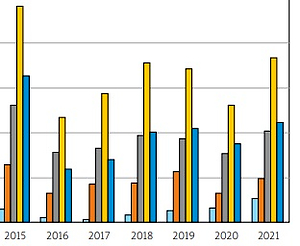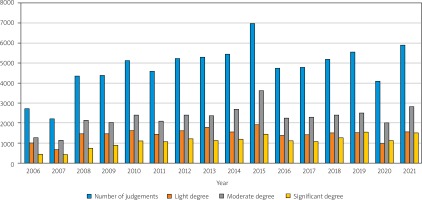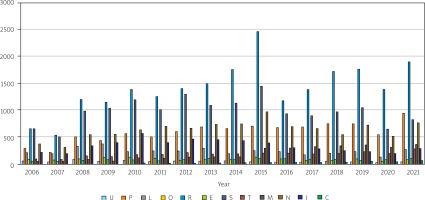Introduction
The population of Poland is 38,383,000. The life expectancy of men is 74.1 years and of women 81.8 years. In Poland the healthy life years (HLY) index is 10 years lower than the life expectancy of men and 12 years for women [1, 2].
The results of the Global Burden of Disease Study indicate ischemic heart disease as the most important cause of health loss in Poland observed for years. Further places in the ranking are occupied by lung cancer, lower back pain and stroke. Among musculoskeletal disorders, osteoarthritis is the most frequent [2].
Musculoskeletal diseases (osteoarthritis, rheumatoid arthritis, psoriatic arthritis) are not a leading cause of mortality but of disability. Therefore they play an important role in the global burden of disease, producing financial costs, need for hospitalization, treatment, rehabilitation, and hiring numerous medical personnel and caregivers in all developed countries [1]. Despite being diagnosed with a disease not everyone applies for a certificate of disability.
In Poland, there are several independent, parallel operating and often confused systems of certifying disability or inability to work. The main dividing line of these systems is that a disability or incapacity assessment can be performed for disability (disability benefits) or non-parental (other than pensions, allowances, entitlements, services or benefits) purposes.
The system which grants the entitlement to disability pensions includes: the Social Insurance Institution (ZUS), the Agricultural Social Insurance Fund (KRUS) and separate certification departments for uniformed services.
In the adjudication system for non-parental purposes, there are: poviat/city disability adjudication teams, voivodeship disability adjudication teams as appeal bodies, and the Ministry of Family and Social Policy as the body supervising the adjudication system about disability [3].
When determining the degree of disability, medical factors are taken into account – the current state of health defined in the regulations as “impaired fitness of the body”, factors related to possible employment defined as ability to work and social factors related to the possibility of independent existence and performing specific social roles. This means that the Polish definition of the phenomenon of disability combines elements of the medical and social model of disability [4].
In the case of persons over 16 years of age, poviat/city disability assessment teams decide not to pass or include in one of the three disability levels: light, moderate or severe. The statutory definition, quoted in full below, sets out the conditions for awarding a particular degree of disability. And so:
A significant degree of disability shall include a person with disturbed body fitness, incapable of work or able to work only in the conditions of sheltered employment and requiring, in order to perform social roles, permanent or long-term care and assistance of other people due to the inability to exist independently.
A moderate degree of disability includes a person with disturbed body fitness, incapable of work or able to work only in sheltered employment conditions or requiring temporary or partial help from other people in order to perform social roles.
A light degree of disability includes a person with disturbed body fitness, significantly reducing the ability to perform work, compared to the ability of a person with similar professional qualifications with full mental and physical fitness, or with limitations in performing roles that are compensable by equipping with orthopedic devices, aids or technical means.
In the case of the two highest degrees of disability (severe and moderate), their common feature is the inability to work or the ability to work only in sheltered employment conditions. The factors differentiating the two highest degrees of disability are:
Inability to live independently, resulting in the need for constant or long-term care and help of other people in order to fulfill social roles (significant degree).
Limitations in fulfilling social roles requiring temporary or partial help of other people in fulfilling these roles (moderate degree).
In the case of a light degree, we are dealing with a person who is able to work, but this ability is significantly limited. However, with regard to the light degree, limitations in fulfilling social roles do not require the care or help of other people, but only appropriate equipment to compensate for deficits [5].
In the first instance (poviat/city disability adjudication teams), the judgments are issued by a panel of at least two persons, and the chairman of the adjudication panel is always a specialist doctor selected according to the patient’s illness/conditions, cooperating, depending on the needs, with a pedagogue, psychologist, and career counselor or a social worker.
The decision on the degree of disability is a collective administrative decision and is subject to the rigors of administrative law, including in particular the time limits for settling the case and the possibility of appealing to the second instance authority, which is the voivodeship disability adjudication team [6].
The medical reasons for issuing the decision are grouped into categories described by the following symbols:
01-U – mental retardation,
02-P – mental diseases,
03-L – voice, speech and hearing,
04-O – eye diseases,
05-R – impairment of the musculoskeletal system,
06-E – epilepsy,
07-S – respiratory and circulatory system diseases,
08-T – diseases of the digestive system,
09-M – diseases of the genitourinary system,
10-N – neurological diseases,
11-I – other diseases including endocrine diseases, metabolic diseases, enzymatic disorders, infectious and zoonotic diseases, deformities, diseases of the hematopoietic system,
12-C – pervasive developmental disorders before the age of 16.
The disability degree certificate includes no more than three causes of disability [7].
The certificate of the degree of disability issued by the poviat/municipal teams for adjudication of disability is not a document which directly indicates the right to receive benefits, rights or services. The scope of available benefits depends on the degree of disability, the type of disease that is the basis for issuing the decision, indications specified in the decision and numerous separate provisions or programs defining the rights resulting from the certificate of the degree of disability.
The certificate of the degree of disability may contain indications concerning:
suitable employment (including employment in an establishment for professional activity),
training (including specialist training),
participation in occupational therapy (occupational therapy workshop),
supply with orthopedic items, aids and technical aids facilitating the daily functioning of a disabled person,
use of social assistance benefits,
obtaining a parking card,
the right to live in a separate room.
The indications depend on the degree of disability, type of disease, and age of the person and are also determined in the context of the expectations and aspirations of the disabled person, who determines the purpose of applying for a certificate [8].
The aim of the study was to investigate the characteristics of people obtaining a disability certificate due to diseases of the locomotor system in Lublin within the last 16 years.
Material and methods
The authors asked the Municipal Disability Adjudication Council in Lublin to provide data on the number of disability certificates issued in the years 2006–2021. The data used for the analysis come from the electronic judicial system that collects and processes them according to the assumed patterns. The adjudication system does not show detailed data in the form of specific persons and specific diseases which are the basis for qualifying a person as a disabled person.
Such data are included in the medical records presented to the medical examiner and due to their nature and the need to protect sensitive data, they may not be processed for purposes other than adjudication. The data collected by the system allow for analysis by age (age ranges), sex, education and whether the adjudicated person is still employed.
The local jurisdiction of the Municipal Disability Adjudication Council in Lublin covers the population residing or staying at the time of the adjudication in the city of Lublin poviat, i.e. a city with poviat rights. This allows us to assume that the dominant group is the urban population.
The population from neighboring communes is adjudicated in the poviat disability adjudication team, which is organizationally different. It is not possible to obtain information about the profession of patients from the data generated by the certification system, but only the data on how many people from the entire group aged over 16 were employed or not.
Results
In the years 2006–2021 the Municipal Disability Adjudication Council in Lublin issued 76,581 disability certificates, the highest number (almost 7,000) in 2015. The most common (48%) was the moderate degree of disability (36,458) (Fig. 1).
The most common reason for being diagnosed with disability was diseases of the locomotor system (22,595 or 30%), while diseases of the heart and respiratory system were in second place (15,648 or 20%) (Fig. 2).
In the years 2006–2013, the majority of people obtaining disability certificates because of bone and joint diseases were in the 41–50 age group. However, from 2014, people from the age group > 60 years predominated (Fig. 3). Of these, 12,842 (57%) were women, and 9,753 (43%) were men (Fig. 4).
Fig. 3
Age groups of people who obtained the decision about disability due to diseases of the locomotor system.
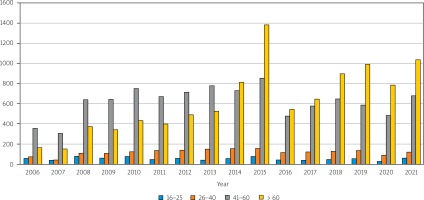
Fig. 4
Classification by gender of people who obtained a certificate of disability due to diseases of the locomotor system.
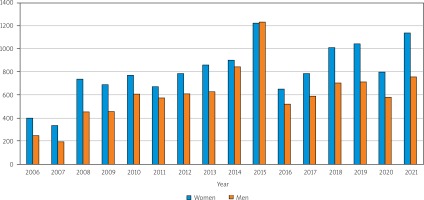
As many as 41% of them had secondary education, less than primary 2%, primary 12%, vocational 23%, and higher education 22% (Fig. 5). As many as 74% were unemployed, while only 36% were employed (Fig. 6).
Fig. 5
The level of education of people who obtained a certificate of disability due to diseases of the locomotor system.
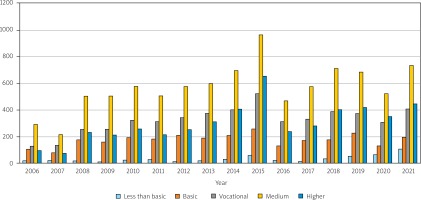
Fig. 6
Employment of people who have obtained a disability certificate due to diseases of the locomotor system.
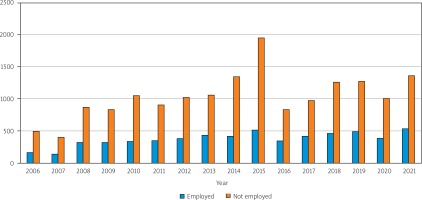
The majority of the patients applying for disability certificate indicated in their forms that they wanted to obtain parking cards, facilitate the search for employment and apply for tax reductions.
Discussion
The fluctuation in the number of disabled people in Poland, and probably also in Lublin, is not only due to medical reasons. The results of the 1988–2011 censuses reveal significant and surprising increases and decreases in the number of people with disabilities.
The 1988 census revealed over 3.2 million such people, the 2002 census more than 4.4 million people with disabilities, and the 2011 census slightly more than 3.1 million people with disabilities [9].
These data can be interpreted in correlation with the state of the country’s economy, where the 1990s can be considered a time of a deep crisis in the labor market. Therefore, obtaining the status of a disabled person could be beneficial for employees at risk of dismissal or the unemployed. In the following years, due to the improved situation in the labor market, obtaining the status of a disabled person was no longer an attractive option for obtaining financial benefits.
Our study recorded a rapid increase in the number of disability certificates issued in 2015 and a sharp decline in 2016. The years 2014–2016 were a period of verification of parking cards entitling the holders to park in disabled areas and to be exempt from obeying certain road signs.
The existing cards expired, and in order to obtain new rights, people had to apply at the local Disability Adjudication Councils for granting the parking card. Hence, in the period, there was a sharp increase, and then an equally sharp decrease in the number of judgments issued for diseases of the musculoskeletal system.
It is not possible to compare the results obtained in this study with other countries because there is no uniform European system for assessing disability or its degree. This is due to various states’ policies in this area.
At the same time, the Polish system can be considered somewhat anachronistic, as it is based on the determination of a given person’s deficits and granting benefits compensating for these deficits. Currently, work is underway to reorient the adjudication towards a method which takes into account, instead of deficits, the possibilities and aspirations of the adjudicated person. It can be assumed that there is a way towards the “aspiration and activation” adjudication.
The organization of adjudication on disability, which has been in force in Poland since 1997, raises numerous controversies. The main weakness of the jurisprudence is that it operates within six non-functionally linked jurisprudence divisions, which adjudicate for different purposes, guided by different criteria for assessing the health and functioning of applicants. This is a serious obstacle for people seeking a ruling, but also requires state funding for several types of judicial institutions [10].
However, researchers have identified many other weaknesses in the disability assessment system, including:
Unclearness and imprecision in qualifying people for particular degrees of disability.
The current archaic nature of solutions adopted 25 years ago.
A negative and stigmatizing nomenclature, focusing on the deficits and weaknesses of the person, and not on their capabilities and aspirations.
The current regulations also do not keep up with technological changes, which means that the personal, social and work life of a disabled person can be maintained at a much higher level of quality than a quarter of a century ago.
The present system also supports the inactivity of disabled people in a way [11].
Currently, analytical and legislative works are underway, the aim of which is to create a draft of provisions consolidating the judicial systems in Poland, both in terms of organization and content, understood as the introduction of uniform criteria for assessing disability [12].
It should be emphasized, however, that the controversy regarding the disability assessment system has been raised for a long time, and the work on the reform of the assessment system has been underway since 2017, when the Interministerial Team for the Development of the Disability Assessment System and Inability to Work was established. The tasks of the team include the analysis of the currently applicable legal and organizational solutions and the preparation of draft assumptions for the act on declaring disability and incapacity for work [13].
Laconic information from the government announced the introduction of the first stage of the judicial system reform in 2024. The changes are to concern only the rules of adjudication by poviat/city disability assessment teams and at this stage will not lead to the announced consistency and uniformity of the disability assessment system [14].
Even in the 1990s it was believed that people with disabilities should not work. Currently, due to the aging of societies and the increase in the percentage of citizens with disabilities, the goal is to create conditions for independence in life and employment of people with disabilities. It is worth recalling the principles of rehabilitation of Professor Wiktor Dega, who emphasized the necessity of simultaneous rehabilitation in the physical and social spheres.
Early detection programs for locomotor diseases (for example rheumatoid arthritis) are equally valuable in order to be able to effectively treat them. Programs that prevent injuries and accidents are also of great importance as most often males aged 10–24 experience injuries and accidents [1, 15].
In 2002, 18.5% of people in Lublin Voivodship had biological disability [16]. In 2011 9% fulfilled legal criteria of disability [17]. In our country people with disability are less educated that healthy ones: only 9% of the disabled have higher education (vs. 22% of the healthy), 30% have secondary education (and 33% of the healthy), 31% vocational education (vs. 21% of the healthy). In Poland 81% of the disabled are not employed [17].
As many as 59% of people with disabilities suffer from musculoskeletal diseases, 47% have cardiovascular diseases, 38% have neurologic disorders, 19% hearing problems, 11% psychiatric diseases and 5% mental retardation [17].
The majority of them report their health problems only to ZUS or KRUS. Only some apply for disability certificates to the poviat/city disability adjudication teams or councils.
The disability assessment process during the COVID-19 epidemic was drastically disrupted. In the first phase of the epidemic, adjudication was suspended and the deadlines for settling cases were extended by law, the possibility of adjudication by default (without the participation of the adjudicated person) was introduced, at the same time, by law, the validity of judgments was extended, the term of which ended during the epidemic, and recently (September 2022) adjudication with the participation of the patient was restored.
In addition to legal and organizational factors, there are also non-measurable factors, such as patients’ fears regarding participation in committees, information chaos, or contradictory guidelines from various authorities as to the rules of adjudicating in an epidemic. In 2020, there was a decrease in the number of judgments in Lublin compared to 2019, and in 2021 and 2022 a sharp increase in the number of judgments.
Conclusions
Based on data from the Municipal Disability Adjudication Council in Lublin, diseases of the musculoskeletal system have been the main reason for adjudication of disability over the last 16 years. Such certificates on the degree of disability make it possible to obtain parking cards, facilitate the search for a job appropriate for the patient’s disability, as well as applying for tax reliefs.


